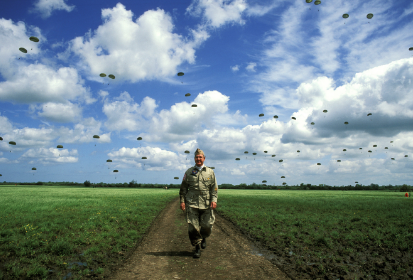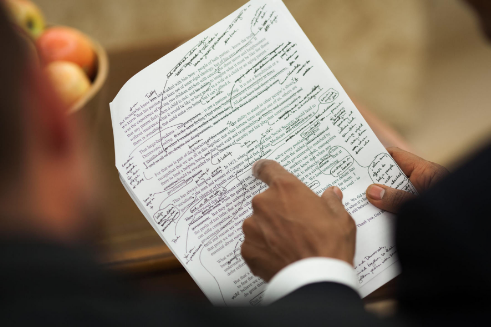Political Photographers Inspire New York Corporate Headshot Photographers!
Can one get political without being political? We think it is possible if it's in service and admiration of 3 very talented photographers. It's 8 days out from the presidential election, so what better time to highlight those photographers that have aimed their camera at the political circus as a serious and, often amusing subject. Like all good photographers, these three offer us distinct windows into a world that is not always accessible to us.
All three of these photographers embrace something of the photojournalistic approach. They cover live action events and are trying to tell a story. The goal is to come back with something that can be published, that stands on its own or enhances a written piece. It somehow expresses an idea that is part of a larger project.
Photojournalists are some of the most committed and dogged professionals in the photography industry. While we New York executive portrait photographers can glean techniques, our challenges pale in comparison to a good photojournalist. They use patience, perseverance and skill to show us what is happening. They hit the road, they goto where the action is and they take pictures of how they see it. A good one operates with the same ethics and unbiased point of view as his/her writer/journalist colleagues.
David Burnett one of our featured photographers is very much a photojournalist. He embraces the tough job of finding the image, making excellent content and making it look easy. But we know that so much work goes into each iconic photo. He must know where his subject will be and find a way to get access. While our New York corporate headshot photographers walk into a space with a scheduled appointment, a journalist might have to hustle his/her way to the front line of a red carpet as a president is disembarking from Air Force One. Or be prepared with the right gear so he/she can shoot behind a chain link fence half a football field away. A journalist might attend a rally thinking that there will be supporters or protestors or something interesting to cover and the event could be a dud.
There's the waiting. The photojournalist could learn about a meeting or something less public that is meant to happen and then sit on a corner for hours until the subject shows up. Or maybe there is a small town that represents a certain population and topic that a newspaper wants to cover. The photographer will go there and just keep looking for the shots that tell the visual story. Instead of waiting, this photographer must learn his/her surroundings, build trust with those who live there and try to gain access in a respectful way.
And then, of course there is the hundreds of photos a photographer might have to take to get the right frame. While our New York business photographers are tethered to a computer, studying the images as they come up, the pace is less forgiving for a photojournalist. Sometimes they get lucky with a promised 5 minutes of access and the perfect shot presents itself. More typically he/she will shoot frame after frame, looking for the right shot.
Three Great Photographers that Influence our Corporate Headshot Photography
3 photographers that we admire who tell such interesting stories with their cameras are David Burnett, Pete Souza and Mark Peterson. They are completely different and fill different roles inside of photojournalism but they all do something unique and admirable.
David Burnett
David Burnett has been an enduring favorite of ours. Burnett has been everywhere, photographing stories for over 6 decades. He has worked with different types of cameras and covered a wide range of subjects. An early photographer, he covered the Vietnam war for Time and Life Magazines. One of his most famous series is 44 Days: The Iranian Revolution from 1978. While he is decidedly a photojournalist, his images blur the line between hard facts and artistic presentation.
While he has covered many famous people, his focus has always been on telling the real life story in real time. He says. 'shoot shoot shoot!' but not without purpose. Find your subject, look for the right shot. Take plenty of frames, but don't use a motorized trigger. When you get the shot a few times, but then move on and look for the next angle.
As a photojournalist, Burnett has photographed presidents and veterans. He has witnessed the ritual of Vietnam Vets monthly cleaning of the Wall in Washington DC. There is the very formal meeting between Reagan and Gorbachev and a casual shot of President Clinton and VP Gore in hair and makeup with Larry King in advance of an interview.
Pete Souza and Covering the White House
When it comes to recognizable names in political photojournalism right now you cannot avoid Pete Souza. He is best known for being President Obama's White House photographer, but his projects are cast wider than just this one subject. Souza also covered the Reagan White House, a story about first year Plebes at the Naval Academy and images from the fall of Kabul. He was part of a Pulitzer Prize winning team covering the airline industry in 2001.
It is hard not to love the images Pete Souza took during his tenure as White House Photographer with President Obama. The images tell the story of our enormously popular first Black president, a handsome first couple and their children, a public figure working with his staff celebrating good news and struggling with terrible information. Here he was covering and open and social media-savvy first president. While he maintains journalistic integrity, we, as corporate headshot photographers, can relate to being pulled in, emotionally to the moments he captures. The pictures are better for it.
In his role as white house photographer, Souza had somewhat easy access. There is tremendous skill in what he did, which was tell the behind the scenes stories of two presidents, but his challenges were in finding those intimate and telling moments.
It is very interesting to contrast Souza's images of Obama with President Reagan. With Reagan there is a greater overall formality: men in suits looking at documents and maps or swarming the oval office. Even more playful images illustrate the more formal personality of this president. In a social moment with Nancy Reagan and Michael Jackson at the White House even Mr. Jackson, in his full regalia, stands properly, hands clasped in front of him, looking off to the side. Out horseback riding we see the president 'at play'. But still, it is picture of a handsome, preppy cowboy with good posture and perfect hair.
Mark Peterson, Political Theater in Photographs
But photographers who cover politics are not all so strictly bound by the rules of journalism. Some are purely there to capture events from their own point of view. Perhaps they are more interested in colors, emotions, shapes, perspective, etc.
The last photographer is someone that is much more confrontational. He is in the room, looking for the shot, shooting from a reportage/documentary perspective. But he asserts a point of view.
Mark Peterson is not out to flatter anyone. He takes the images he see, but uses different camera angles, vibrant colors and action to reveal the drama. He does a raw-feeling story about a basketball at the famous 4th Street court in New York City. He also covers his fair share of celebrities and entertainment industry subjects.
When Peterson points his lens at a political subject he pulls no punches. His collection, Political Theater covers much of the 2016 election. He uses his photography techniques to amp up the theatricality of the presidential race, covering candidates and supporters. He includes super tight portraits of an expression and equally tight portraits of a patriotic accessory.
We think about this in relation to our corporate headshot photography. Our takeaway is how we can use technique to amp up the flattering qualities of a shot. The goal is not to lie, but to take a photo that best serves the purpose of the shoot.
There are no lies in what he is delivering through his photography, but there is a clear perspective. The story is Political Theater and his images deliver on that theme.
There are so many ways to cover politics, but these three photographers cover an interesting range of what exists. During a time that is so fraught with extreme feelings, it is nice to appreciate the field of political photography for creative art that it is.
As we enter into an election, we are thankful to have these photographers out there reporting back to us. We appreciate that the work they put into bringing us stories that are not available to us. We can tune out of our news channels droning on and recycling the same material and turn to photographers who bring us closer together to a depth of experience that is hard to see elsewhere.






















